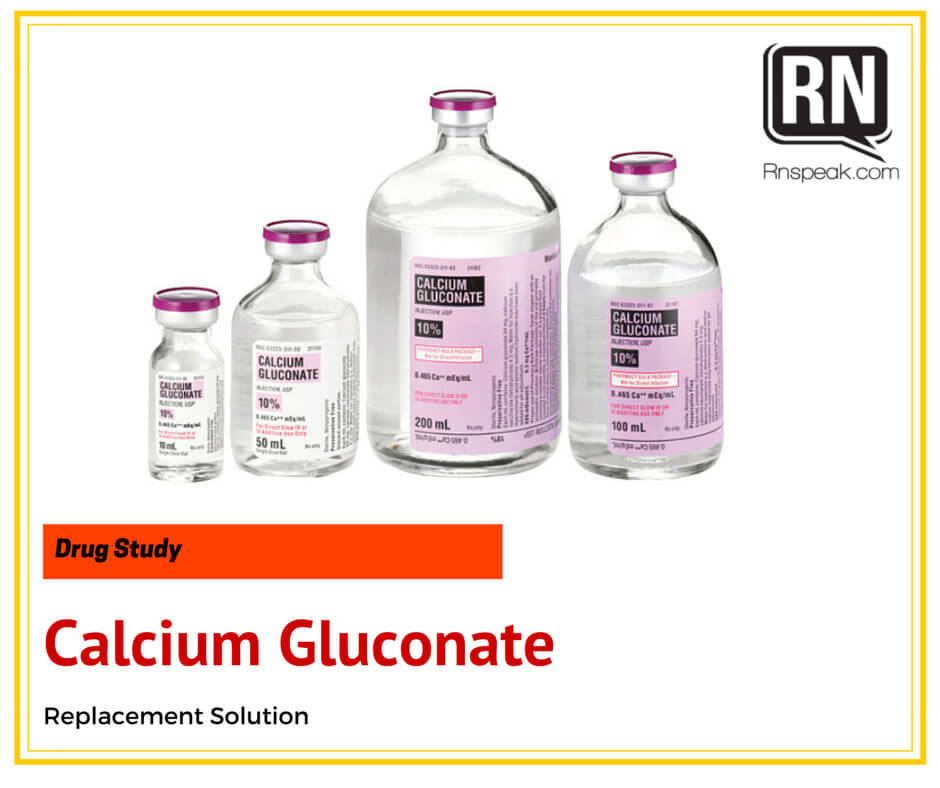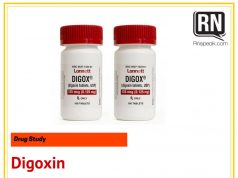
Generic Name: Calcium Gluconate
Brand Name: Kalcinate
Classifications: fluid and electrolytic and water balance agent; replacement solution
Pregnancy Category: B
Availability
500 mg, 650 mg, 975 mg, 1 gm tablets; 10% injection
Actions
Calcium is an essential element for regulating the excitation threshold of nerves and muscles, for blood clotting mechanisms, cardiac function (rhythm, tonicity, contractility), maintenance of renal function, for body skeleton and teeth. Also plays a role in regulating storage and release of neurotransmitters and hormones; regulating amino acid uptake and absorption of vitamin B12, gastrin secretion, and in maintaining structural and functional integrity of cell membranes and capillaries. Calcium gluconate acts like digitalis on the heart, increasing cardiac muscle tone and force of systolic contractions (positive inotropic effect).
Therapeutic effects
Rapidly and effectively restores serum calcium levels in acute hypocalcemia of various origins and effective cardiac stabilizer under conditions of hyperkalemia or resuscitation.
Uses
Negative calcium balance (as in neonatal tetany, hypoparathyroidism, vitamin D deficiency, alkalosis). Also to overcome cardiac toxicity of hyperkalemia, for cardiopulmonary resuscitation, to prevent hypocalcemia during transfusion of citrated blood. Also as antidote for magnesium sulfate, for acute symptoms of lead colic, to decrease capillary permeability in sensitivity reactions, and to relieve muscle cramps from insect bites or stings. Oral calcium may be used to maintain normal calcium balance during pregnancy, lactation, and childhood growth and to prevent primary osteoporosis. Also in osteoporosis, osteomalacia, chronic hypoparathyroidism, rickets, and as adjunct in treatment of myasthenia gravis and Eaton-Lambert syndrome.
Contraindicatons
Ventricular fibrillation, metastatic bone disease, injection into myocardium; administration by SC or IM routes; renal calculi, hypercalcemia, predisposition to hypercalcemia (hyperparathyroidism, certain malignancies); pregnancy (category B).
Cautious use
Digitalized patients, renal or cardiac insufficiency, sarcoidosis, history of lithiasis, immobilized patients; lactation.
Route & Dosage
Supplement for Osteoporosis
adult: PO 1–2 g b.i.d. to q.i.d.
IV 7 mEq q 1–3d
child: PO 45–65 mg/kg/d in divided doses.
IV 1–7 mEq q 1–3d
neonate: PO 50–130 mg/kg/d (max 1 g).
IV mEq q 1–3d
Hypocalcemic Tetany
adult: IV 4.5–16 mEq prn
child: IV 0.5–0.7 mEq/kg t.i.d. or q.i.d.
neonate: IV 2.4 mEq/kg/d in divided doses
CPR
adult: IV 2.3–3.7 mEq x 1
Hyperkalemia with Cardiac Toxicity
adult: IV 2.25–14 mEq q 1–2 min
Exchange Transfusions with Citrated Blood
adult: IV 1.35 mEq for each 100 mL of blood
neonate: IV 0.45 mEq for each 100 mL of blood
Administration
Oral
- Ensure that chewable tablets are chewed or crushed before being swallowed with a liquid.
- Give with meals to enhance absorption.
Intravenous
PREPARE direct: May be given undiluted intermittent: /continuous: May be diluted in 1000 mL of NS.
ADMINISTER direct: Give direct IV at a rate of 0.5 mL or a fraction thereof over 1 min. Do not exceed 2 mL/min. intermittent: /continuous: Give slowly, not to exceed 200 mg/min, through a small-bore needle into a large vein to avoid possibility of extravasation and resultant necrosis. With children, scalp veins should be avoided. Avoid rapid infusion. High concentrations of calcium suddenly reaching the heart can cause fatal cardiac arrest.
Incompatibilities Solution / Additive: Amphotericin B, cefamandole, dobutamine, methylprednisolone, metoclopramide. Y-site: Amphotericin B cholesteryl complex, fluconazole,
Indomethacin.
- Injection should be stopped if patient complains of any discomfort. · Patient should be advised to remain in bed for 15–30 min or more following injection, depending on response.
Adverse Effects
BodyWhole: Tingling sensation. With rapid IV, sensations of heat waves (peripheral vasodilation), fainting.
GI: PO preparation: Constipation, increased gastric acid secretion.
CV: (With rapid infusion) hypotension, bradycardia, cardiac arrhythmias, cardiac arrest,
Skin: Pain and burning at IV site, severe venous thrombosis, necrosis and sloughing (with extravasation).
Nursing Implications
Assessment & Drug Effects
- Assess for cutaneous burning sensations and peripheral vasodilation, with moderate fall in BP, during direct IV injection.
- Monitor ECG during IV administration to detect evidence of hypercalcemia: decreased QT interval associated with inverted T wave.
- Observe IV site closely. Extravasation may result in tissue irritation and necrosis.
- Monitor for hypocalcemia and hypercalcemia.
- Lab tests: Determine levels of calcium and phosphorus (tend to vary inversely) and magnesium frequently, during sustained therapy. Deficiencies in other ions, particularly magnesium, frequently coexist with calcium ion depletion.
Patient & Family Education
- Report S&S of hypercalcemia promptly to your care provider.
- Milk and milk products are the best sources of calcium (and phosphorus). Other good sources include dark green vegetables, soy beans, tofu, and canned fish with bones.
- Calcium absorption can be inhibited by zinc-rich foods: nuts, seeds, sprouts, legumes, soy products (tofu).
- Check with physician before self-medicating with a calcium supplement.
- Do not breast feed while taking this drug without consulting physician.







